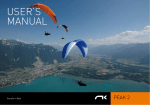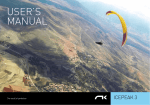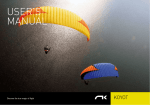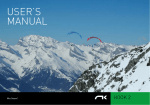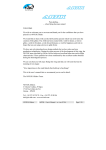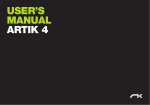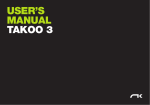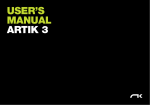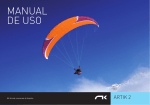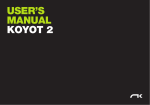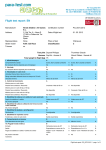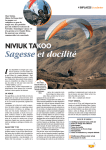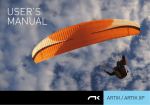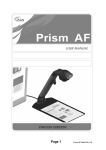Download USER`S MANUAL
Transcript
USER’S MANUAL Where the Sport begins ARTIK 2 WELCOME We wish to welcome you to our team and thank you for the confidence that you have placed in a NIVIUK Glider. We would like to share with you the thrill and the passion which was involved in the creation of this glider. The ARTIK 2 has been created with a wish for desire, a wish to glide, a wish for freedom, a wish for performance, a wish for happiness and wish to forget that you are using a devise to glide freely. Using the same CAD design technology as used on our new generation competition glider the ICEPEAK 3, we have been able to bring to you the very latest Sports glider, the ARTIK 2. With this technology and our expertise the ARTIK 2 is a glider designed for complete and pure flying pleasure, allowing you to realise your wildest paragliding dreams. Even in the strongest of conditions the high level security does not falter, you will remain confident and always at one, in total harmony with your glider. We are sure that you will enjoy flying this wing and that you will soon find out the meaning of our slogan: “Give importance to the small details that build up to big things” This is the user’s manual that we recommend you to read in detail. The NIVIUK Gliders Team. NIVIUK Gliders C/ Doctor Codina, 29 bajos 17165 La Cellera de Ter Girona - SPAIN Tel. +34 972 42 28 78 Fax +34 972 42 00 86 [email protected] www.niviuk.com 2 USER’S MANUAL NIVIUK Gliders ARTIK 2. This manual offers all the necessary information that will familiarize you with the main characteristics of your new paraglider. Although this manual informs you about your glider, it does not offer the instruction requirements necessary for you to be able to pilot this type of wing. Flying instruction can only be taught at a paragliding school recognised by the Flying Federation of your country. Nevertheless we remind you that it is important that you carefully read all the contents of the manual for your new ARTIK 2 glider. Severe injuries to the pilot can be the consequence of the misuse of this equipment. SUMMARY WELCOME 2 5.2 B-LINE STALL USER’S MANUAL 2 5.3 SPIRAL DIVE 10 1. CHARACTERISTICS 4 6. SPECIAL METHODS 10 1.1 WHO IS IT DESIGNED FOR? 4 6.1 TOWING 10 1.2 HOMOLOGATION 4 6.2 ACROBATIC FLIGHT 10 1.3 IN-FLIGHT BEHAVIOUR 4 7. FOLDING INSTRUCTIONS 11 1.4 ASSEMBLY, MATERIALS 4 8. CARE AND MAINTENANCE 11 1.5 ELEMENTS, COMPONENTS 5 8.1 MAINTENANCE 11 2. UNPACKING AND ASSEMBLY 5 8.2 STORAGE 11 2.1 CHOOSE THE RIGHT PLACE 5 8.3 CHECKS AND CONTROLS 11 2.2 PROCEDURE 5 8.4 REPAIRS 11 2.3 ASSEMBLY OF THE HARNESS 5 9. SAFETY AND RESPONSIBILITY 11 2.4 TYPE OF HARNESS 5 10. GUARANTEE 12 2.5 ASSEMBLY OF THE ACCELERATOR 5 11. TECHNICAL DATA 13 2.6 INSPECTION AND WING INFLATION ON 11.1 TECHNICAL DATA 13 6 11.2 MATERIALS DESCRIPTION 13 2.7 ADJUSTING THE BRAKES 6 11.3 RISER ARRANGEMENT 14 3. THE FIRST FLIGHT 6 11.4 LINE PLAN 15 3.1 CHOOSE THE RIGHT PLACE 6 11.5 LENGTHS ARTIK 2 23 16 3.2 PREPARATION 6 11.6 LENGTHS ARTIK 2 25 16 3.3 FLIGHT PLAN 6 11.7 LENGTHS ARTIK 2 27 17 3.4 PRE-FLIGHT CHECK LIST 6 11.8 LENGTHS ARTIK 2 29 17 11.9 CERTIFICATION SPECIMEN 18 THE GROUND 3.5 WING INFLATION, CONTROL, AND TAKEOFF 10 6 3.6 LANDING 7 4. IN FLIGHT 7 4.1 FLYING IN TURBULENCE 7 4.2 POSSIBLE CONFIGURATIONS 7 4.3 USING THE ACCELERATOR 9 4.4 FLYING WITHOUT BRAKE LINES 9 4.5 KNOTS IN FLIGHT 9 5. LOSING HEIGHT 9 5.1 BIG EARS 9 3 1. CHARACTERISTICS 1.1 WHO IS IT DESIGNED FOR? The ARTIK 2 has been designed for pilots who want to open the door of the cross country world. The original Artik set a new EN C benchmark yet the performance and safety of the ARTIK 2 supersedes even that by a huge margin. Fly with confidence, without restrictions or compromise, the ARTIK 2 brings you security and performance like no other EN C available today. The wing’s safety is guaranteed by its excellent homologation certifications. It is worthwhile remembering that the best paraglider in the hands of a bad pilot does not guarantee a happy ending. The ARTIK 2’s passive safety measures should also be accompanied by the passive safety offered by the rest of the flying equipment. The harness, helmet, emergency parachute etc. The extraordinary behaviour of the ARTIK 2 and common-sense piloting will give you many hours of peaceful flying. The objective of the ARTIK 2 with an uncomplicated 3-riser system and a single D line we have ensured minimal drag with maximum line efficiency to offer you the maximum performances with the best security glider for the EN C class. 1.2 HOMOLOGATION 1.4 ASSEMBLY, MATERIALS ARTIK 2 takes the EN C certification with success. This certification is the proof of good performance with very good security. Check the homologation results and figures on the last pages of this manual. 1.3 IN-FLIGHT BEHAVIOUR In order to accomplish the second demand required by the ARTIK 2, the NIVIUK Team has carried out extensive and meticulous design work. As a consequence of several prototypes and many hours of test flights numerous adjustments were made. These prototypes were then tested in all types of flight conditions. This intense development work supported by the combined experience of the whole team has achieved a wing with unbeatable behaviour. Light handling, precise response, manoeuvrable, safe, aesthetic and high with performance, these are just some of the qualities of this wing. The wing’s behaviour on the ground is the first quality of its obedient temperament. Its lightness, in weight as in command is so decisive that all actions that are taken during the flight result in total liberty. This wing’s performance will make quite clear that lightness and efficiency are complementary concepts. Even in the most turbulent conditions all instructions are diligently transmitted and the response given by the ARTIK 2 is the expected response. The pilot will discover the manoeuvrability of this wing in all the aspects of piloting, allowing the pilot to explore beyond his/her present knowledge without running the risk of an incorrect response of the ARTIK 2. 4 The ARTIK 2 does not only introduce new design methods but also new manufacture technologies. Not a single millimetre of error is possible in the manufacturing process from Olivier’s computer to the cutting of the fabric. The cutting is done section by section in an extremely meticulous manner. The numbering and marking of the guideline marks is also done in the same meticulous way so avoiding errors in this critical process. The lines are semi-automatically manufactured and all the sewing is finished under the supervision of our specialists. The jigsaw puzzle of the assembly process is made easier using this method. We economize on resources while making the quality control more efficient. All the different parts of the canopy are cut and assembled under the strict conditions induced by the automation of the whole process. All NIVIUK Gliders go through an extremely thorough and efficient final inspection. Every single line of each glider is measured individually once the final assembly has concluded. Each wing is thoroughly inspected at the end of it assembly. Each glider is packaged following the maintenance and conservation instructions recommended for the advanced materials. NIVIUK Gliders are made of first class materials as demanded by the performance, durability, and homologation requirements of the present-day market. Information about construction materials is given on the last pages of this manual. 1.5 ELEMENTS, COMPONENTS 2.3 ASSEMBLY OF THE HARNESS The ARTIK 2 is delivered to its owner together with a series of components that, although not fundamental, do take an important part in the use, transport and storage of the paraglider. The glider is delivered together with a rucksack, large enough for all of the equipment to fit inside, once appropriately packed. The rucksack is designed to make transport on foot as pleasant as possible. The internal bag, intended to protect the ARTIK 2 from possible damage, during storage is also supplied. The glider strap allows you to fold the wing as small as possible. Furthermore you will find the accelerator bar that completes the acceleration gear of the wing, a small fabric repair kit made of auto-adhesive ripstop, a pair of special handles for more precise piloting and a user’s manual with the answers all our questions about our new ARTIK 2. Correctly place the risers on the harness karabiners. The risers and lines should not have any twists and they should be in the right order. Check that the harness buckles are correctly locked. 2. UNPACKING AND ASSEMBLY 2.4 TYPE OF HARNESS The ARTIK 2 has passed the EN C certification using an ABS type harness. This certification allows it to be flown with most of the harnesses on the market. We recommend that you adjust the distance of the chest strap according the homologation. This varies according to the size of the wing. 42 cm for size 23, 44 cm for size 25, 46 cm for sizes 27 and 29. Any change made to these specifications may affect the wing’s performance and reactions. This would therefore effect the glider’s configuration and would not conform to the homologation. 2.1 CHOOSE THE RIGHT PLACE 2.5ASSEMBLY OF THE ACCELERATOR We recommend that you unpack and assemble your wing on a schooling slope or a flat clear area without to much wind and free of obstacles. These conditions will allow you to carry out all the steps required for you to check and inflate the ARTIK 2. We recommend that an instructor or a retailer supervises the entire procedure as only they are competent to resolve any doubt in a safe and professional way. 2.2 PROCEDURE Take the paraglider out of the rucksack, open it and spread it open with the lines on top of the underside, position the wing as if you were to inflate it. Check the condition of the fabric and the lines, make sure there are no abnormalities. Check the maillons that attach the lines to the risers are properly closed. Identify and order the A, B, C, and D lines, the brake lines and the corresponding risers. Make sure that there are no ties or knots. The acceleration mechanism of the ARTIK 2 works when you push with your feet on the accelerator bar, this is supplied with the equipment. On delivery the accelerator bar has not yet been installed and it is recommended that it is fit by yourself before flight. Most harnesses are equipped with a preinstalled acceleration system. When fitting any accelerator system ensure that all preinstalled items within the harness, such as roller pulleys are used correctly. After fitting, take into account that you will have to adjust the length of the accelerator lines for correct use. This will vary according to the length of the pilot’s legs! We recommend that you try the correct fitting of the acceleration system on equipment designed to do this, most paragliding schools have this sort of equipment. 5 2.6INSPECTION AND WING INFLATION ON THE GROUND 3.2 PREPARATION Once you have checked all the equipment and made sure that the wind conditions are favourable, inflate your ARTIK 2 as many times as necessary in order to become acquainted with the wing’s behaviour. The ARTIK 2 inflates easily and smoothly. An excess of energy is not necessary and the wing will inflate with minimum pressure on the harness when you move forward. This may be assisted by using the A lines. Do not pull on them, just accompany the natural rising movement of the wing. Once the wing is in the 12 o’clock position, simply apply correct pressure on the brake lines and the ARTIK 2 will sit over your head. Repeat the procedures detailed in chapter 2 (UNPACKING AND ASSEMBLY) in order to prepare your equipment. 2.7 ADJUSTING THE BRAKES The length of the main brake lines is adjusted at the factory to the length established during homologation. However, the length can be changed to adapt to the pilot’s flying style. Nevertheless, we recommend that you fly for a while with these, set at the original length. This will allow you to become accustomed to the ARTIK 2’s original flying behaviour. If you then decide to change the length of the brake lines, untie the knot, slide the line through the brake link to the desired length, and strongly re-tie the knot. Qualified personnel should carry out this adjustment. You must ensure that this adjustment does not slow down the glider without any pilot input. Both brake lines should be symmetrical and measure the same length. The most recommended knots are the clove hitch knot or bowline knot. 3. THE FIRST FLIGHT 3.1 CHOOSE THE RIGHT PLACE We recommend that the first flight with your ARTIK 2 is made on a smooth slope (a school slope) or in your usual flying area accompanied by a qualified instructor. 6 3.3 FLIGHT PLAN Draw out a flight plan before take-off in order to avoid possible flight errors. 3.4 PRE-FLIGHT CHECK LIST Once you are ready, but before you take-off, carry out another equipment inspection. Ensure correct installation of all equipment and that all lines are free of hindrances or knots. Check that the weather conditions are suited for your flying skills. 3.5 WING INFLATION, CONTROL, AND TAKE-OFF Smoothly and progressively inflate the wing (chapter 2.6 INSPECTION AND WING INFLATION ON THE GROUND). The ARTIK 2 inflates easily and does not require excessive energy. It does not tend to over-take you, so the wing inflation phase is carried out without anguish. These take off characteristics provide a perfect control phase and enough time for the pilot to decide whether to accelerate and take off. Whenever the wind speed allows it, we recommend a reverse launch technique, this type of launch allows you to carry out a better visual check of the wing. The ARTIK 2 is especially easy to control in this position in strong winds. However, wind speeds up to 25 to 30 km/h are considered strong and extra consideration should be given to any thought of flight. Preparation and positioning of the wing on the take off is especially important. Choose a location which is appropriate for the direction of the wind. Position the paraglider as if it were part of a large circle, taking into account the shape of the canopy in flight. All this will assist in a trouble free take-off. 3.6 LANDING The ARTIK 2 lands excellently, it transforms the wing speed into lift on the pilot’s demand, allowing an enormous margin of error. You will not have to wrap the brake lines around your hand to get greater braking efficiency. 4. IN FLIGHT 4.1 FLYING IN TURBULENCE The ARTIK 2 complies with an excellent homologation to face this type of situation with the best safety guarantee. A leading edge very similar to the ones used on our competition gliders not only provides solid stability at high speed but also one which is more robust and more suited to the elements endured by this section of the glider. The performance of the ARTIK 2 during turbulence is nothing short of incredible, at low or high speeds the ARTIK 2 will allow you to confidently deal with even the roughest of air without the fear of excessive pitch or roll. This wing is stable in all types of weather conditions. It reacts admirably in passive flight, thus offering a high level of safety in turbulent conditions. Nonetheless, all paragliders always have to be piloted according to the prevailing weather conditions, the pilot is the ultimate safety factor. We recommend that the pilot adopts a proactive attitude when flying, making the necessary fine adjustments to keep the wing in control. He/she should stop braking to allow it to fly at the required wing speed after a correction is made. Do not maintain any correction for longer than necessary (braked) this would cause the wing to enter into critical flying situation. Whenever necessary, control a situation, react to it and then re-establish the required speed. 4.2 POSSIBLE CONFIGURATIONS We recommend that training to master these manoeuvres be carried out under the supervision of a competent school. Asymmetric collapse In spite of the great stability of the profile of the ARTIK 2, heavy turbulent conditions may cause part of the wing to collapse asymmetrically. This usually happens when the pilot has not foreseen this possible reaction of the wing. When the wing is about to experience an asymmetric collapse the brake lines and the harness will transmit a loss of pressure to the pilot. To prevent the collapse from happening, pull the brake line corresponding to the compromised side of the wing, this will increase the angle of incidence. If the collapse does happen the ARTIK 2 will not react violently, the turn tendency is very gradual and it is easily controlled. Lean your body towards the side that is still flying in order to counteract the turn and to maintain a straight course, if necessary slightly slow down the same side. The collapse will normally open by itself but if that does not happen, pull completely on the brake line on the side which has collapsed (100%). Do this with a firm movement. You may have to repeat this operation to provoke the re-opening. Take care not to over-brake on the side that is still flying (turn control) and when the collapse has been solved, remember to let the wing recover its flying speed. Symmetric collapse In normal flying conditions the design of the ARTIK 2 ensures that a symmetric collapse is quite improbable. The profile of the wing has been designed to widely tolerate extreme changes in the angle of incidence. A symmetric collapse may occur in heavy turbulent conditions, on entry or exit of strong thermals or lack of adapting the use of the accelerator to the prevailing air conditions. Symmetrical collapses usually re-inflate without the glider turning but you can symmetrically apply the brake lines with a quick deep pump to quicken the re-inflation. Release the brake lines immediately to recover optimum flight speed. Negative spin This configuration is out of the normal flight behaviour of the ARTIK 2. Certain circumstances however, may provoke this configuration such as trying to turn when the wing is flying at very low speed (while heavily braking). It is not easy to give any recommendations about this situation since it varies depending 7 on the circumstances. Remember that you should restore the relative air speed over the wing. To achieve this, progressively reduce the pressure on the brake lines and let the wing gain speed. The normal reaction would be a lateral surge with a turn tendency no greater than 360º before restoring to normal flight conditions. Parachutal stall The possibility of this happening has been eliminated by the design of the ARTIK 2 and it is highly unlikely to happen on this paraglider. If it does happen, the feeling would be that the wing would not be advancing, you would feel a kind of instability and a lack of pressure on the brake lines, although the canopy would appear to be correctly inflated. The correct reaction would be to release the pressure on the brake lines and push the A lines forward or rather lean your body to any side WITHOUT PULLING ON THE BRAKE LINES. Deep stall The possibility of the ARTIK 2 falling into this configuration during normal flight is very unlikely. This could happen if you are flying at a very low speed, whilst over steering in a number of manoeuvres and in turbulent conditions. To provoke a deep stall you have to take the wing to minimum flight speed by symmetrically pulling the brake lines, when you reach this point, continue pulling until you reach 100% and then hold. The glider will first fall behind you and then situate itself above you, rocking slightly, depending on how the manoeuvre was carried out. When you start to provoke a stall, be positive and do not doubt an instant. Do not release the brake lines when half way through the manoeuvre. This would cause the glider to surge violently forward with great energy and may result in the wing below the pilot. It is very important that the pressure on the brake lines is maintained until the wing is well established vertical above. To regain normal flight conditions, progressively and symmetrically release the brake lines, letting the speed be re-established. When the wing reaches the maximum advanced position ensure that the brakes are fully released. The wing will now surge forward, this is necessary so that air speed is completely restored over the wing. Do not over brake at this point because 8 the wing needs to recover speed to quit the stall configuration. If you have to control a possible symmetrical front stall, briefly and symmetrically pull on the brake lines and let go even when the wing is still ahead of you. Wing tangle Of all the possible situations, which you may encounter while flying the ARTIK 2, this is the least probable one of all. The well proportioned ratio and well calculated positioning of the line cascades ratify this fact. A wing tangle may happen after an asymmetric collapse, the end of the wing is trapped between the lines. This situation could rapidly cause the wing to turn, although it depends on the nature of the tangle. The correction manoeuvres are the same as those applied in the case of an asymmetrical collapse, control the turn tendency by applying the opposite brake and lean your body against the turn. Then locate the line that reaches the stabiliser that is trapped between the other lines. This line has a different colour and belongs to the external lines of the B riser. Pull on this line until it is tense, this should help to undo the wing tangle. If you cannot undo the tangle, fly to the nearest possible landing spot, control the flying course with your body movements and a little pressure on the opposite brake. Be careful when attempting to undo a tangle if you are flying near a mountainside or near to other paragliders, you may lose control of the flying course and a collision may occur. Over handling Most flying incidents are caused by wrong actions of the pilot, which chained one after another create abnormal flying configurations (a cascade of incidents). You must to remember that over handling the wing will lead to critical levels of functioning. The ARTIK 2 is designed always to try to recover normal flight by itself, do not try to over handle it. Generally speaking, the reactions of the wing, that follow over handling, are neither due to the input made or the intensity, but the length of time the pilot continues to over handle. You have to allow the profile to re-establish normal flight speed after any type of handling. 4.3 USING THE ACCELERATOR The profile of the ARTIK 2 has been designed to fly stable through its entire speed range, the EN C certification confirms this. It is useful to accelerate when flying in strong winds or in extreme descending air. When you accelerate the wing, the profile becomes more sensitive to possible turbulence and closer to a possible frontal collapse. If you feel a pressure loss, you should stop pushing on the accelerator and pull slightly on the brake lines to increase the angle of incidence. Remember that you have to re-establish the flight speed after correcting the incidence. It is NOT recommended to accelerate near to the mountainside or in very turbulent conditions. If necessary you will have to constantly adjust the movements and pressure on the accelerator whilst constantly adjusting the pressure applied to the brake lines. This balance is considered to be “active piloting.” 4.4 FLYING WITHOUT BRAKE LINES If, for any reason at all, you cannot use the brake lines of your ARTIK 2 you will have to pilot the wing using the D-risers and your body weight to fly towards the nearest landing. The D-lines steer easily because they are not under pressure, you have to be careful not to over handle them causing a stall or negative turn. To land you have to let the wing fly at full speed and before reaching the ground you will have to pull symmetrically on both the D-risers. This braking method is not as effective as using the brake lines so you will land at a higher speed. 4.5 KNOTS IN FLIGHT The best way to avoid these knots and tangles is to inspect the lines before you inflate the wing for take-off. If you notice a knot before take off, immediately stop running and do not take-off. If you have taken-off with a knot you will have to correct the drift by leaning on the opposite side of the knot and apply the brake line on that side too. You can gently pull on the brake line to see if the knot becomes unfastened or try to identify the line with the knot in it. The identified line can then be pulled to see if the knot undoes. Be very careful when trying to remove a knot. When there are knots in the lines or when they are tangled, do not pull too hard on the brake lines because there is a greater risk of the wing to stalling or negative turn being initiated Before trying to remove a knot, make sure there are no pilots flying nearby and never try these manoeuvres near the mountainside. If the knot is too tight and you cannot remove it, carefully and safely fly to the nearest landing place. 5. LOSING HEIGHT The knowledge of the different descent techniques is an important resource to use in certain situations. The most adequate descent method will depend on the particular situation. We recommend that you learn to use these manoeuvres under the tuition of a competent school. 5.1 BIG EARS Big ears are a moderate descent method, reaching –3 or –4 m/s, ground speed reduces slightly between 3 and 5 km/h and piloting becomes limited. The angle of incidence and the surface wing load also increases. Push on the accelerator to restore the wing’s horizontal speed and the angle of incidence. To pull big ears take the outermost A-lines of both stabilizers as high up as possible and pull on them outward and downward. The wingtips will fold in. Let go of the lines and the big ears will re-inflate automatically. If they do not re-inflate, gently pull on one of the brake lines and then on the opposite one. We recommend that you re-inflate asymmetrically, not to alter the angle of incidence, more so if you are flying near the ground or flying in turbulence. 9 5.2 B-LINE STALL When you carry out this manoeuvre, the wing stops flying, it loses all horizontal speed and you are not in control of the paraglider. The air circulation over the profile is interrupted and the wing enters into a situation similar to parachuting. To carry out this manoeuvre you have to take the B-lines below the maillons and symmetrically pull both of them down (approx. 20-30cms) and then hold this position. The initial phase is quite physical (hard resistance) which means that you will have to pull strongly until the profile of the wing is deformed, when this happens the required force will then significantly reduce. To maintain this manoeuvre you must continue to hold the B Lines in the pulled down position. The wing will then become deformed, horizontal speed drops to 0 km/h and vertical speed increases to –6 to –8 m/s depending on the conditions and how the manoeuvre has been carried out. To exit the manoeuvre, simultaneously release both risers, the wing will then slightly surge forward and then automatically return to normal flight. It is better to let go of the lines quickly rather than slowly. This is an easy manoeuvre but you must remember that the wing stops flying, it loses all horizontal movement and its reactions are very different compared to normal flight. 10 A paraglider flying at its maximum turn speed can reach –20 m/s, equivalent 70 km/h vertical speed and stabilize in a spiral dive from 15 m/s onwards. These are the reasons why you should be familiar with and know how to carry out the exit methods. To exit this manoeuvre you must progressively release the inside brake and also momentarily apply outside brake. Whilst doing this you must also lean your bodyweight towards the outside. This exit manoeuvre has to be carried out gradually and with smooth movements so you can feel the pressure and speed changes at the same time. The after effect of the exit manoeuvre is that the glider will rock briefly with lateral surge, depending on how the manoeuvre has been carried out. Practice these movements at sufficient altitude and with moderation. 6. SPECIAL METHODS 6.1 TOWING The ARTIK 2 does not experience any problem when being towed. Only qualified personnel should handle the qualified equipment to carry out this operation. The wing has to be inflated in the same way as in normal flight. 5.3 SPIRAL DIVE 6.2 ACROBATIC FLIGHT This is a more effective way for rapidly losing height. You have to know that, the wing can gain a lot of speed and the increase in g’s will be substantial. This can cause a loss of orientation and consciousness (blackouts). These are the reasons why it is best to carry out this manoeuvre gradually so your capacity to resist the g forces increases and you will learn to fully appreciate and understand the manoeuvre. Always practice this manoeuvre when flying at high altitude. To start the manoeuvre, first lean your bodyweight and pull the brake line to the side to which you are leaning. You can regulate the intensity of the turn by applying a little outside brake. Although the ARTIK 2 has been tested by expert acrobatic pilots in extreme situations, it HAS NOT been designed for acrobatic flight and we DO NOT recommend continued use in this type of flight. Acrobatic flight is the youngest discipline in free flight. We consider acrobatic flight to be any form of piloting that is different to normal flight. To learn safely how to master acrobatic manoeuvres you should attend lessons which are carried out by a qualified instructor and over water. Extreme manoeuvres take you and your wing to centrifugal forces that can reach 4 to 5g. Materials will wear more quickly than in normal flight. If you do practice extreme manoeuvres we recommend that you send your wing to an authorized test center for a complete inspection at least once a year. 7. FOLDING INSTRUCTIONS Use of a correct folding method is important for extending the useful life of your paraglider. It should be folded like an accordion, ensuring that the (SLE) leading edge reinforcements remain flat. This method will keep the profile in good shape without altering its form or its performance. Be careful that the reinforcements are not bent or twisted. The wing does not have to be tightly folded, if you do so it may damage the material or the lines. 8. CARE AND MAINTENANCE 8.1 MAINTENANCE I you take good care of your equipment it will performance will be maintained. The fabric and the lines do not need to be washed, if they become dirty, clean them with a soft damp cloth. If your wing gets wet with salty water, immerse it in fresh water and dry it away from direct sunlight. The sunlight may damage the materials of your wing and cause premature aging. Once you have landed, do not leave the wing in the sun, store it properly. If you use your wing in a sandy area, try to avoid the sand from entering through the cell openings of the leading edge. If sand is inside the wing, remove it before folding. Technological advancements have allowed us to use the best possible materials. The material used for the lines of the ARTIK 2 now offers much more strength and longevity than lines used on earlier gliders. However, we strongly advise that extra care be taken with all lines and abrasion, knots and extreme force be avoided. 8.2 STORAGE Temperatures inside a car parked in the sunlight, can be very high. Inside a rucksack and in the sunlight temperatures can reach 60ºC. Weight should not be laid on top of the equipment. 8.3 CHECKS AND CONTROLS You should ensure your ARTIK 2 is periodically serviced and checked at your local repair shop every 100 hours of use or once a year (whichever happens first). This is the only way to guarantee that your ARTIK 2 will continue to function properly and therefore continue fulfilling the homologation certificate results. The ARTIK 2 has to endure a line inspection in function of the use and the terrain abrasion in which you evolve. 8.4 REPAIRS If the wing is damaged, you can temporarily repair it by using the rip stop that you’ll find in the repair kit, so long as no stitches are involved in the tear. Any other type of tear must be repaired in a specialized repair shop or by qualified personnel. Do not accept a home repair. 9. SAFETY AND RESPONSIBILITY It is well known that paragliding is considered a high-risk sport, where safety depends on the person who is practising it. Wrong use of this equipment can cause severe injuries to the pilot, even death. Manufacturers and dealers are not responsible for any act or accident that may be the result of practicing this sport. You must not use this equipment if you are not trained. Do not take advice or accept any informal training from anyone who is not properly qualified as a flight instructor. It is important that the wing is correctly folded when stored. Store your flying equipment in a cool, dry place away from solvents, fuels or oils. It is not advisable to store your flying equipment in the trunk of your car. 11 10. GUARANTEE The entire equipment and components are covered by a 2 year guarantee for any manufacture fault. The guarantee does not cover misuse or abnormal use of the materials. 12 11. TECHNICAL DATA 11.2 MATERIALS DESCRIPTION 11.1 TECHNICAL DATA ARTIK 2 23 25 27 29 Canopy Fabric codeSupplier CellsNumber 60 60 60 60 Upper surface Skytex 40 9017 E77NCV (France) 8 8 8 8 Bottom surface Skytex 40 9017 E38NCV (France) Box 31 31 31 31 Profiles Skytex 40 9017 E29NCV (France) FlatAream2 23 25 27 29,5 Diagonals Skytex 40 9017 E29NCV (France) 11,55 12,04 12,51 13,08 Loops LKI - 10 Kolon industRial (Korea) Aspect ratio 5,8 5,8 5,8 5,8 Reinforcement loops W-420 D-P (Germany) ProjectedAream2 19,57 21,25 22,93 25,02 Trailing edge reinforcement Mylar 25 m/m D-P (Germany) 9,26 9,43 9,78 10,22 Ribs reinforcements W-420 D-P (Germany) 4,19 4,19 4,19 4,19 Thread Serafil 40AMAN (Germany) Closed Spanm Span M Aspect ratio % 15 15 15 15 Cord MaximuMm 2,5 2,61 2,71 2,83 Suspension lines Fabric codeSupplier Minimumm 0,53 0,55 0,57 0,59 Upper cascades DC - 60 1,99 2,07 2,15 2,25 Middle cascadesTNL - 80Teijin Limited (Japan) Flattening Average LIROS (Germany) LinesTotal metersm 285 298 309 323 Middle cascadesTNL - 140Teijin Limited (Japan) 6,82 7,11 7,39 7,72 MainTNL - 80Teijin Limited (Japan) Number 224 224 224 224 MainTNL - 140Teijin Limited (Japan) 3/3/4/1 3/3/4/1 3/3/4/1 3/3/4/1 MainTNL - 220Teijin Limited (Japan) Heightm Main risersNumber 4A/B/C/DA/B/C/DA/B/C/DA/B/C/D Main breakTNL - 220Teijin Limited (Japan) TrimsNONONONO Thread Total weight MINIMUMkg 105 60 75 90 Serafil 60AMAN (Germany) MAXIMUMkg 80 95 110 130 risers Glider weightkg 5,3 5,6 5,8 6,2 Material 3455 CertificationEN C C C C Color indicator PAD Techni Sangles (France) 2 2 2 2 in flight LTF Fabric codeSupplier Cousin Trestrec (France) ThreadN/F-66 Young Chang T&C LTD Maillons MRDI03.5 S12 Peguet (France) Pulleys 224 Harken (USA) 13 11.3 RISER ARRANGEMENT 14 11.4 LINE PLAN 15 11.5 LENGTHS ARTIK 2 23 11.6 LENGTHS ARTIK 2 25 Niviuk ARTIK 2 23 Niviuk ARTIK 2 25 Lines height cm. Lines height cm. A B CDbr A B CDbr 1 682 673,5 676,5 694 761,5 1 706 697,5 701 719,5 786,5 2 678 669 671,5 685,5 741,5 2 702 693,5 695,5 711 766 3 672,5 664,5 667 675,5 725 3 697 688 691 700 748,5 4 674 666 669,5 678,5 717 4 698 689,5 693,5 703 740 5 666 659,5 662 672 696,5 5 690,5 682,5 686 696,5 719 6 661,5 655 657 667,5 687 6 685,5 678 680,5 691,5 708,5 7 656 650,5 652,5 671,5 683,5 7 679 673,5 676 696 705,5 8 657 652 655 678 687,5 8 680 675 678,5 702,5 709 9 646,5 642,5 648,5 679 9 669,5 665 671,5 700 10 642,5 639 644 672,5 10 665,5 661 667 693,5 11 630,5 628,5 632,5 674,5 11 653 650 655 695,5 12 628 626 630,5 657 12 650,5 647,5 652,5 677,5 13 618 617 622,5 13 640 638,5 644,5 14 616,5 615,5 621,5 14 638,5 637 643,5 15 590 588,5 593 15 611 609 614 16 577,5 578,5 583,5 16 598 598,5 603,5 16 Risers lengths cm. Risers lengths cm. A B CD A B CD 49 49 490 490 49 49 49 49 31 34,5 430 490Accelerated 31 34,5 43 49Accelerated Standard Standard 11.7 LENGTHS ARTIK 2 27 11.8 LENGTHS ARTIK 2 29 Niviuk ARTIK 2 27 Niviuk ARTIK 2 29 Lines height cm. Lines height cm. A B CDbr A B CDbr 1 734,5 725 728,5 747,5 819 1 772,5 762,5 766 786,5 860 2 730 721 723,5 738,5 797,5 2 768,5 758 760,5 777 837,5 3 724,5 715,5 718,5 727 779,5 3 761,5 752,5 755,5 765 818,5 4 726 717 721 730 770,5 4 763 754 758,5 768 809 5 717,5 709,5 713 723,5 749 5 755 746,5 750,5 761 786 6 713 705 707,5 719 738 6 750 742 744,5 756 775 7 706 700 703 723 735 7 743 737 739,5 760,5 771,5 8 707,5 701,5 705,5 730 739 8 744 738,5 742,5 768 776 9 695,5 691,5 698 729 9 732 728 735 766 10 691,5 687,5 693,2 722,5 10 727,5 723,5 730 759 11 678 676 680,5 724,5 11 714 711,5 716,5 761 12 675,5 673,5 678 705,5 12 711 709 714 741,5 13 665 664 670 13 700 699 705,5 14 663,5 662 669 14 698,5 697 704,5 15 635 633,5 638 15 668,5 666,5 671,5 16 621,5 622,5 628 16 654,5 655,5 661 Risers lengths cm. Risers lengths cm. A B CD A B CD 49 49 49 49 49 49 49 49 31 34,5 43 49Accelerated 31 34,5 43 49Accelerated Standard Standard 17 11.9 CERTIFICATION SPECIMEN Class: C Class: PG_0229.2009 Date of issue (DMY): 14. 05. 2009 Manufacturer: Niviuk Gliders / Air Games S.L. Model: Artik II 23 In accordance with EN standards 926-2:2005 & 926-1:2006: PG_0206.2009 14. 04. 2009 Niviuk Gliders / Air Games S.L. Artik II 25 Date of issue (DMY): Manufacturer: Model: Serial number: Serial number: Configuration during flight tests Configuration during flight tests Paraglider Accessories Paraglider Accessories Maximum weight in flight (kg) 80 Range of speed system (cm) 16 Maximum weight in flight (kg) 95 Range of speed system (cm) 16 Minimum weight in flight (kg) 60 Speed range using brakes (km/h) 13 Minimum weight in flight (kg) 75 Speed range using brakes (km/h) 13 Glider's weight (kg) 5 Range of trimmers (cm) 0 Glider's weight (kg) 5.6 Range of trimmers (cm) 0 Number of risers 4 Total speed range with accessories (km/h) 28 Number of risers 4 Total speed range with accessories (km/h) 28 Projected area (m2) 19.57 Projected area (m2) 21.25 Harness used for testing (max weight) 18 C In accordance with EN standards 926-2:2005 & 926-1:2006: Inspections (whichever happens first) Harness used for testing (max weight) Harness type ABS every 12 months or every 100 flying hours Harness type ABS every 12 months or every 100 flying hours Harness brand Sup'Air Warning! Before use refer to user's manual Harness brand Warning! Before use refer to user's manual Harness model Altiplume M Person or company having presented the glider for testing: None Niviuk Gliders Harness model Hamak M Harness to risers distance (cm) 49 Person or company having presented the glider for testing: None Distance between risers (cm) 42 Harness to risers distance (cm) 49 Distance between risers (cm) 45 1 2 3 4 5 6 7 8 9 10 11 12 13 14 15 16 17 18 19 20 21 22 23 24 A A B A A A A A B C A A A C A A A A A B A A A 0 Inspections (whichever happens first) 1 2 3 4 5 6 7 8 9 10 11 12 13 14 15 16 17 18 19 20 21 22 23 24 A A A A A A A A B B A A A C A A A A A B B A A 0 Class: C Class: PG_0205.2009 Date of issue (DMY): 14. 04. 2009 Manufacturer: Niviuk Gliders / Air Games S.L. Model: Artik II 27 In accordance with EN standards 926-2:2005 & 926-1:2006: C PG_0230.2009 14. 05. 2009 Niviuk Gliders / Air Games S.L. Artik II 29 In accordance with EN standards 926-2:2005 & 926-1:2006: Date of issue (DMY): Manufacturer: Model: Serial number: Serial number: Configuration during flight tests Configuration during flight tests Paraglider Accessories Paraglider Accessories Maximum weight in flight (kg) 110 Range of speed system (cm) 16 Maximum weight in flight (kg) 130 Range of speed system (cm) 16 Minimum weight in flight (kg) 90 Speed range using brakes (km/h) 13 Minimum weight in flight (kg) 105 Speed range using brakes (km/h) 13 Glider's weight (kg) 5.8 Range of trimmers (cm) 0 Glider's weight (kg) 6 Range of trimmers (cm) 0 Number of risers 4 Total speed range with accessories (km/h) 28 Number of risers 4 Total speed range with accessories (km/h) 28 Projected area (m2) 22.93 Projected area (m2) 25.02 Harness used for testing (max weight) Inspections (whichever happens first) Harness used for testing (max weight) Harness type ABS every 12 months or every 100 flying hours Harness type ABS Inspections (whichever happens first) every 12 months or every 100 flying hours Harness brand Sup'Air Warning! Before use refer to user's manual Harness brand Niviuk Warning! Before use refer to user's manual Harness model Evo XC L Person or company having presented the glider for testing: Cizeau Dominique Harness model Hamak M Person or company having presented the glider for testing: None Harness to risers distance (cm) 48 Harness to risers distance (cm) 48 Distance between risers (cm) 46 Distance between risers (cm) 46 1 2 3 4 5 6 7 8 9 10 11 12 13 14 15 16 17 18 19 20 21 22 23 24 1 2 3 4 5 6 7 8 9 10 11 12 13 14 15 16 17 18 19 20 21 22 23 24 A A B A A A A A B B A A B C A A A A A B B A A 0 A A A A A A A A B B A A B C A A A A A B B C A 0 19 The importance of small details Bisgràfic niviuk.com




















